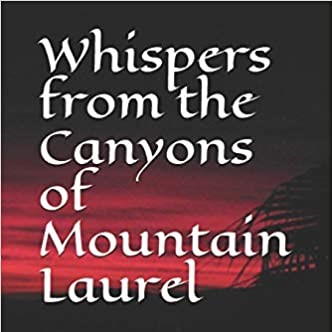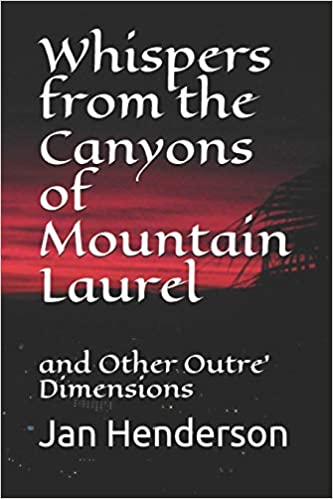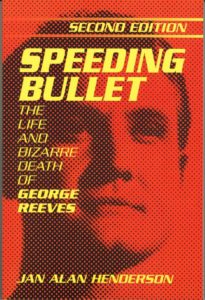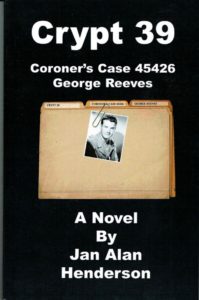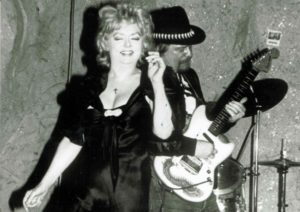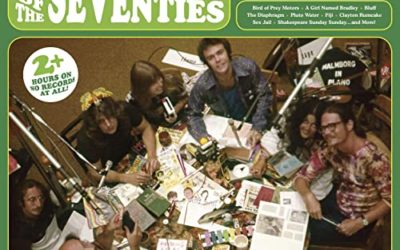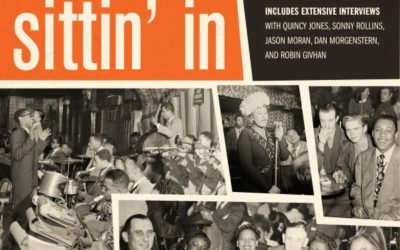Whispers From the Canyons of Mountain Laurel is the eleventh book project Jan Henderson has been involved in, and a career that spans three and a half decades.
It is his second foray into fiction, after writing film and television articles and essays for periodicals FilmFax, American Cinematographer, and Cult Movies.
Amazon describes Whispers From the Canyons of Mountain Laurel as “An intriguing collection of original and unusual very short stories by author Jan Alan Henderson, these stories are from uncomplicated times in Hollywood, and some from lifetimes not yet lived. Great snippets for a brief escape from reality; these tales, while short, linger in the imagination.”
Speeding Bullet and Behind the Crimson Cape are available from Oldies.com. Crypt 39 and Whispers From the Canyons of Mountain Laurel are available from Amazon.com.
On the eve of publication of his short story collection, Henderson sat down with Harvey Kubernik.
Q: Regarding the Whispers book, can you compare and contrast doing a collection of short stories instead of your usual expeditions that make Perry Mason episodes and researchers look like amateurs.
A: Completely different. Going into it, I thought fiction would be easy because I had no limits. Then the iron hand of reality pointed its finger at me and made me realize that I had to write something that made sense to other people. My job on a project like this is to take people away from everyday reality, the same as radio and television did for our parents’ generation. Remember, they didn’t have computers, flatscreen TVs, with thousands of choices before them.
Q: As far as literary influences, you’ve cited the work of Andrew Loog Oldham, going all the way back to his marvelous liner notes on the back covers of Rolling Stones’ albums 1964-1967.
A: There’s only one Andrew Loog Oldham on this planet! He was one of the architects of popular culture as we know it today. While people like Brian Epstein pulled strings with telephones and assistants, Andrew was pounding the pavement making things happen. The original Street Fighting Man.
Not only did he have the plan, he made it work. Imagine if there hadn’t been that blond headed guy brimming over with ideas (and the guts to put them over) where the music would have gone. Next to nowhere.
Here’s a guy that broke a band in the shadow of the four-headed monster that sang “Yea, yea, yea.” His timing is and was impeccable. Andrew’s liner notes on those pivotal early Stones albums drew the reader in and set the scene for eggshell minds with eager ears for what would lay between the groves.
Yes, Andrew Loog Oldham has always been a great influence on me. I highly recommend his Stoned series for all students of popular culture.
Q: I learned how to drive in Laurel Canyon. Our Driver’s Education class at Fairfax High School in West Hollywood in 1968 and ’69 was taught there.
Tell me about the world of Laurel Canyon 1960-1970. You went to Hollywood High School after Lowell George who later founded Little Feat. The music/recordings of many Laurel Canyon-based musicians still survive and thrive on radio, soundtracks, vinyl, mono, streaming platforms. Why?
A: To answer the last part first: there was nothing else like it before or since. A goodly amount of this book is exploring places like Laurel Canyon, Bronson Canyon, and what came to be known as Hollywood landmarks that we played in as kids. There was an overall hope of optimism, even in those trying times, and there was an openness about creativity throughout those locations that I don’t think would be possible today. There was trust.
Lowell George was rehearsing next door to where I lived, with the Factory. I used to warn the band when the neighbors would call the police about the noise. I was closest to the drummer, Richie Hayward. Lowell George went to Hollywood High School several years before I got there.
Q: Laurel Canyon has always been a region populated by actors, musicians and what Deepak Chopra told me, “Cultural Creatives.”
A: Cultural Creatives is a perfect term for what we experienced back then. I don’t mean to disagree with Dr. Chopra on this, but the level of creativity seems to have diminished in the passing decades.
Q: You new book really brings us into aspects of Laurel Canyon we don’t read much about. Tell me about the concept for this book, why did you embark on the journey, and utilizing the short story format.
A: Well, as your readers may or may not know, I have been affiliated and published on the bizarre death of George Reeves for 25 years. The reason I did my first novel four years ago on the last ten years of George Reeves’ life was, people kept asking me what I thought. What the Speeding Bullet series laid out was a collection of stories and interviews that I did with the intent of allowing the readers to decide for themselves.
The short story angle came from being frustrated when I was a kid reading short story anthologies that had long, wordy passages that slowed the pace (to my mind). So what I wanted to do was change the format a little bit and make it like the pulp magazine Weird Tales meets classic Hammer Horror films. One thing about the golden age of Hammer, those films were never boring.
Q: I always heard there were UFO sightings in Laurel Canyon but teachers and media, local newspapers dismissed it. I seem to recall you or friends of yours saw it.
A: The question is: what was it? A friend and I were driving on Laurel Terrace one afternoon, and saw what we believed were two orange orbs. Now, they could have been weather balloons, but they probably weren’t drones because I don’t think they had those in the early 70s. I’m still trying to figure that out, and haven’t come up with anything. Who knows, they may come back to beam me up!
Q: I briefly touched on it in my 2008 book Canyon of Dreams The Magic and the Music of Laurel Canyon. Tell me about the once-hidden observation deck in the hills. Rumor has it going back to WW2, so there was a location to spy on potential submarines and aircraft coming from Japan. A father of a friend of mine worked in the military facility on the top of Laurel Canyon during WW2. She mentioned they made demonstration and propaganda films there.
A: I never heard the term “observation deck.” Military installation was more of what we knew it as. We would sit on a knoll across the small canon it was located in, and hope to see whatever was supposed to be going on. Nothing ever happened.
Q: Kids used to smoke weed on the premises. Apparently it became some sort of recording studio. Musician Rick Rosas, who was with Neil Young for years, and in the re-formed Buffalo Springfield, referenced the observation deck to me during a 2008 interview.
A: I was never on the premises. Across the Canyon is where everyone I knew went. There was a rumor that it was used as a location for an Outer Limits episode, but there were plenty of places that could have been used. Maybe it was the hanger where they kept the flying saucers, maybe not.
Q: You began pop culture journalism decades ago. I read your work in FilmFax. Horror and Science-Fiction were topics you have chronicled. We’ve been in this Hollywood world scene for sixty years. Did you ever see Bela Lugosi do a live appearance? Weren’t you at the first preview or debut of Star Trek where the cast was introduced?
Is there any way you can bring us into 1955-1980 Hollywood as a kid, teenager and young adult. You saw James Dean on Sunset Blvd. And Basil Rathbone.
A: I was first published in January of 1987, in FilmFax Issue Number 6. Mike Stein (publisher/editor) took a chance on me way back when. It was an interview with Paul Marco, who was one of the Ed Wood players. This was an issue that contained pieces by Ed Wood biographer Rudolph Grey. I had contacted FilmFax because I had done an interview with Director Lee Sholem in March of 1978. I wanted the interview to be published because the newsletter I had done the work for went belly-up.
I never intended to be a writer. It was supposed to be a one-off. Mike Stein has asked me for some information on Ed Wood, so that’s how I came in contact with Paul Marco and did the interview.
I never saw Bela Lugosi live. The first genre film I saw was King Kong in 1956. A year or thereabouts later, I was at the same friend’s house when they showed Frankenstein on television. When Boris Karloff walks into the laboratory backwards, we tried to dig a hole in the carpet and hide. At that time I was aware of Bela Lugosi, but had never seen him in person or on film. I didn’t see Dracula until a little later on. At Gardner Street School, all the kids had Famous Monsters so I was aware of Lugosi through the magazine. I would have loved to have met Bela, but no such luck.
I wasn’t at the preview of Star Trek. I met William Shatner, Leonard Nimoy, and Deforest Kelly at Westercon Twenty in the summer of 1967. Gene Roddenberry was on hand, and screened the black and white pilot, The Cage.
At Sunset and Fairfax Avenue were the grocery store and drug store where we shopped. There was a restaurant called Googies in the area. I saw James Dean through the window once or twice, but didn’t know him or who he was. That came later. I also had contact with Mali Nurmi later in her life. She was the first TV horror movie hostess, Vampira.
Basil Rathbone would walk his dog on Sunset Boulevard, which is where I would see him, but didn’t know about Sherlock Holmes until later.
Q: We’ve discussed previously the impact of writers Rod Serling and Sterling Sillaphant and watching their morality plays and leaving us to decide endings of their TV-penned shows.
Why are The Twilight Zone, Route 66 and The Fugitive even more relevant these days? You still view and collected full seasons of these landmark, revealing and educational episodic black and white television series including Naked City and One Step Beyond?
Is it the writing and the direction? You also dug Outer Limits. Vintage science-fiction with elements of horror and reality. Joe Stefanko knew what he was doing. Did the world look and feel better then when we saw it in black and white?
A: Serling, Sillaphant, and the viewing menu of 60s black and white television shows allow audience participation. This has always had an effect on my writing; making readers think and participate with the work. Twilight Zone, The Outer Limits, One Step Beyond, and Star Trek all fall into that category.
The reader involvement began for me with the Speeding Bullet series. It’s part of Whispers. Actor John Agar and I agreed that what you don’t see or perceive is much more frightening.
The early 60s were the peak of this kind of writing. Just before the Kennedy assassination, some new kids moved into the neighborhood. The father was a writer named Mann Rubin. I used to go on Sunday outings to a local park to play softball. On the way to and from the park, he had an AM radio station, KNX, on in the car, which on Sundays reran old radio shows like The Shadow and The Green Hornet. Rubin wrote the first version of Brainstorm in 1965, starring Jeffery Hunter. Hunter was Captain Pike in the unsold Star Trek pilot The Cage.
Also, I had made the acquaintance of writers like Ray Bradbury, Robert Block, and A.E. van Vogt this all figures into the mix of Whispers. Less words, more imagination.
The world did look better in black and white!
Q: Local Southern California television was really cool in the late fifties and sixties. A corporate mentality emerged in the seventies and then the changes in programming the last half century At least on cable TV we can see science fiction, drama, westerns and entertainment of that period.
What was the beauty of seeing first run movies in the fifties and sixties on Hollywood Blvd. and Sunset Blvd., besides eating at the Young China restaurant? I would imagine you first walked into Musso & Frank in the fifties. After 1963 I lived at The Pix, The Hawaiian, The Oriental, The Gordon, The Vogue, and The Pan Pacific-Theater. Parking was free!
A: Those were magical formative days. The neighborhood kids didn’t realize that the movie business was on the wane. The Oriental was where Guitar Center Hollywood is located now. I caught the last gasp of the Saturday Matinee Kiddie Shows there. A serial chapter, cartoons, later Three Stooges shorts, and a western or science fiction/horror feature, all including popcorn and candy for a quarter.
We went to the Gordon down on La Brea every now and then to see their Saturday matinee. The theaters on Hollywood Boulevard were the “A” houses that showed first-run features. I saw House of Usher and other Roger Corman flicks. We also saw Hammer films on Hollywood Boulevard.
The restaurant Young China was a spot where we had family dinners. Lunches after The Oriental were eaten at the Sunset Grill, where Steve McQueen used to hang out before The Magnificent Seven came out. We had dinners on Friday nights at Musso’s
Q: You regularly frequented Wallichs Music City, the Phil Harris record shop and the landmark Lewin Record Paradise. A retail world before Tower Records arrived in 1970 on Sunset Blvd.
A: Lewin Record Paradise, Phil Harris, and The Groove Company were where we bought our records. The playback booths at Wallichs Music City is where we hid to avoid being busted for curfew. That was well before Tower Records.
Q: You knew Dennis Hopper as a kid. Didn’t he and his wife Brooke live near you in Laurel Canyon? Dennis introduced you to the debut LP by the Canadian band, the Paupers?
A: The first story in Whispers details my meeting Dennis Hopper. He had seen me and my friends making our 8mm amateur movies, and came to my house to see if I was the kid who made the movies. He was an amazing man, turned on to Pop Art before it was all the rage. He had The Paupers album, which he played for me. I bought my copy at Phil Harris Records along with the first H.P. Lovecraft LP. Dennis and his wife Brooke lived four doors away from my house.
Q: You had brief encounters with the Doors’ Jim Morrison. We saw the band in the late sixties.
A: That’s documented in your Turn Up the Radio! Rock, Pop and Roll 1956-1972 book. I set up vocal mics for an overdub session at Sunset Sound on a sunny morning in 1970. He also picked me up hitchhiking on Laurel Canyon sometime later. He displayed none of the behavior of the infamous Lizard King. Very soft spoken and kind to a wet-behind-the-ears kid, who was trying to get into the music business.
In October of 1969 I was at Sunset Sound, and the Rolling Stones were coming over from Electra Studios after doing overdubs, to mix in Studio Two. One of their associates was at Burbank Airport, so I helped arrange transport from the airport to Sunset Sound, and was there for the playback and rough mixing in Studio Two.
Mick Jagger, Mick Taylor (whom I had seen play with John Mayall at the Shrine Exposition Hall the year before) and Charlie Watts were there. That evening Keith Richards was the host with the most. Forty minutes with the greatest Rock and Roll band meant I was floating home instead of walking!
Q: Before this Whispers book, you wrote bio-regional action-packed sleuthing titles on actor George Reeves, who starred in the TV series The Adventures of Superman, chronicled in Speeding Bullet and Crypt 39. Why did you invest and devote hundreds of hours to the life and strife of Reeves? You sure present evidence that explained his last day on earth.
A: George Reeves did not get a fair shake in life or death. He was loved by all who knew him, but some took advantage of his good nature. In March of 1978 I interviewed director Lee Sholem, my first interview. He directed Superman and the Mole Men. It was for Nostalgia Merchant Monthly newsletter, which did not last but one or two installments. It sat for eight years before it made it to print. Another connection to The Adventures of Superman show was my godmother was a guest star on a first season episode, Cecil Elliott in The Evil Three.
So, over the decades I looked into it. It was never intended to be published. The advance announcement for the book Hollywood Kryptonite changed all that. Speeding Bullet was put out May of 1995 as a book-a-zine by Cult Movies, issue number fourteen. The late Dave Stevens did the cover, and named the book.
My investigation was casual, not obsessive. It started in 1967, Halloween to be precise, with an article about unsolved deaths in Benedict Canyon, by Joe Hyams in the West Magazine Sunday supplement of The Los Angeles Times. The article was entitled Haunts for Halloween.
Q: In late 1957 when I was living with my family in Crenshaw Village we saw Reeves in his Superman costume doing a personal appearance at the May Company store. He was on the roof bending steel.
I know in the case of George Reeves his life, career and “suicide” it was always the local gossip as a kid there was much more to this scenario that would now make a 10-part mini-series. Two years later his death was on the cover of all the newspapers. Your investigative efforts are admirable. What do your two books on Reeves further explain to us about this Benedict Canyon tragedy?
A: It would make a whole season of shows. My friend Lou Koza put out the George Reeves Archives series, tracing the history of George Reeves and friends, a year or so ago. Speeding Bullet is a condensed version. Lou’s work traces Reeves and friends from beginning to end.
Q: In my Canyon of Dreams book, I devoted a chapter to actor/playwright Jack Larson who portrayed cub reporter Jimmy Olson in the Superman TV series. We discussed the Doors and Laurel Canyon of the fifties and sixties. He lived there or hung out in the area with actress Leslie Caron.
A: I never knew Jack lived in Laurel Canyon in the fifties. He told me that he met Jim Morrison at UCLA.
Q: One thing I talked with Larson about was the fact that TV actors like him and others for their fifties and early sixties TV work only received seven residual checks after initial broadcast or something like that. Wasn’t Ronald Reagan a factor when he was president of SAG around 1960? Were Larson and other Superman cast members irked?
A: Jack Larson and Noel Neill voiced their frustration with the residual situation to me, years after the Reagan ruling. They felt he was responsible. Jock Mahony and John Agar never mentioned it. That was a shameful situation.
Q: You were a member of a groovy breakfast club in Hollywood and North Hollywood 30 years ago noshing weekly with real Hollywood veterans.
A: In the eighties I got to meet and become friends with my Saturday Matinee heroes; people like Terry Frost, Pierce Lydon, and Richard Webb. Those were golden days. You don’t find many people like that these days.
Q: Your book on Rocky Jones, Space Ranger. Why? I seem to remember as a tyke it was on TV. You knew actress Dian Fauntelle, who worked with Roland Reed around the time of My Little Margie, Waterfront and Rocky Jones.
A: It was offered to me. Dian Fauntelle was a neighbor who I re-met, and interviewed for FilmFax. She had called Mike Stein (publisher/editor of FilmFax) with corrections on a Rocky Jones piece from years ago. The best way to make the corrections was to have her tell her side of the story. She was Roland Reed’s girlfriend for 25 years.
Q: Your book on the legendary Lydecker Brothers. They were independent folks who developed lighting techniques that are still utilized in TV and movies.
A: The Lydeckers were the in-house special effects men from the beginning of Republic Pictures. I went to Hollywood High School with Ted’ son George, and did an article on the brothers for American Cinematographer in the mid-nineties. The book expanded on the magazine work. The Lydecker book has been out of print for two years, and it’s now being offered on E-Bay for astronomical prices. Go figure!
Q: You and I have always admired and touted the real pioneers of independent movie production: Sam Katzman, Samuel Z, Arkoff, James H. Nicholson and Roger Corman. What drew you to their work? They are the ones who changed the worldwide frame game. And, early on were scorned by traditional Hollywood studios and distributors. You interviewed Roger Corman recently.
A: I interviewed Roger Corman for FilmFax when he and his wife started their YouTube channel. It was a press junket by phone, with a time allotment of 30 minutes. What amazed me about Mr. Corman was, if I mentioned someone’s name, he would give me the person’s whole background with a story or two, in an unbelievably short amount of time.
There’s a possible reason for my stories in Whispers being so short – maybe it’s what isn’t written that means the most! The reader’s imagination should be part of the process. Arkoff, Nicholson, Katzman, and countless other filmmakers showed us you could make quality product without throwing a lot of money around. The same holds true for music.
Q: You were always in bands going back to the sixties. And had a stint in a music publishing office affiliated with MCA. You always championed the music and records of The Mandala, a Canadian band that had a following in Hollywood. The singer, George Oliver had a strong voice and their light show was awesome. I saw them with you in late 1966 or ‘67 at The Kaleidoscope in Hollywood.
I have a greasy memory of going afterwards to the Hollywood Ranch Market at 2:00 am. You devoured chicken gizzards. That turned me into a vegetarian for about a week! Hollywood had some sense of freedom, but I know you were stopped, frisked and hassled by cops for curfew because you had longhair.
You also had a stint at the Gazzarri’s nightclub where you shared bookings with Pacific Ocean, fronted by Eddie Olmos, now actor/producer. Edward James Olmos. He is pictured in the inside cover of the Eric Clapton debut solo LP.
A: Right. I was a band hanger-on with the Abstracts, which played Gazzaris’s, with Eddie James and the Pacific Ocean, and the Hour Glass.
That was also a time when I was slightly involved with The Soul Crusade of the Mandala. Their light machine (which was custom built) was stolen in 1966 here in LA. I managed to get it back for them, with no one getting pinched.
I was with the Mandala the day Sergeant Pepper came out. The LP was brought in by one of their crew. Don Troiano and Don Elliot had a record player in their room, and after we played the whole thing the two Dons thought the Beatles had lost their musical course. I was sitting in front of the three inch speaker. I had never heard anything like that. I was mesmerized! My life changed in Don Troiano’s hotel room. That started my musical adventures.
Years later I was part of a song-writing workshop at MCA. Publishing at 1777 N. Vine Street. Duane Eddy was there to help teach young songwriters the ins and outs. I will always be grateful for the time I was allowed with him.
Q: Didn’t you have a band with actress Yvette Vickers? She was in American International Pictures’ Reform School Girl, and was Honey Parker in Attack of the 50 Foot Woman, and a small role in Hud. Let’s talk about the music and recordings you did with her.
A: Nyck Varoom’s Tomb was a band I put together after I left the Haunted Garage. I met Yvette around that time at a friend’s house. She was with Dave Stevens, who did the Rocketeer and the Cult Movies Speeding Bullet issue. I had a song called “Leeches” which she ended up singing on, both live and for the lost Nyck Varoom’s Tomb album. We already had an EP out, and we were putting an album together. She came from a musical family; both her parents were musicians.
Yvette was a multi talent. It’s a crime she wasn’t a star, because she had the goods! People remember her death, which is terribly sad. She was a great friend for three years, and I shall always treasure our time.
Q: How about your own music this decade. I did make it a point in Canyon of Dreams to showcase and display photos of musicians like you, a resident since 1960, along with current century songwriters, singers and record producers now living in Laurel Canyon
A: Today my music is more soundtrack music. Soundtrack for what, I don’t know. I’ve recorded on everything from a Realistic cassette machine to a twenty-four track, so it’s an open field. Remember, some of the basic tracks for the Stones classic Beggars Banquet were recorded on a Phillips cassette record. As Keith Richards might say, “Wing it, boys!”
Q: You’ve always acknowledged the music of King Crimson and the sonic visionary, Robert Fripp. Your first experience seeing his band. What still draws you to his work?
A: Who plays like Robert Fripp? No one! Crimson and Fripp never play it safe. What more could one want! King Crimson changed my life the same as Sergeant Pepper. I saw them at the Whisky A Go Go in December of 1969. I had heard Crimson on radio station KNAC Long Beach before that, and it sounded like evil Moody Blues. They opened with “21st Century Schizoid Man” (which I hadn’t heard), and my head exploded. Never to be repaired.
I mentioned that night to Robert Fripp at a Crimson Collectors Club get together in 1996. He told me that Eric Burdon heckled them during that entire engagement.
Let’s face it, these are troubling times. Maybe Whispers can provide some relief and escape. Thank you.
(Harvey Kubernik is the author of 19 books, including Canyon Of Dreams: The Magic And The Music Of Laurel Canyon and Turn Up The Radio! Rock, Pop and Roll In Los Angeles 1956-1972.
In 2014 Harvey Kubernik and author Jan Alan Henderson were feature interview subjects for London, England-based BBC Radio 4 and their radio documentary California Dreaming, Laurel Canyon, produced by Andy Parfitt, which chronicled the Southern California music scene of the sixties and early seventies.
Kubernik, along with Lenny Waronker, Gary Burden, and Dwight Yoakam discussed the former and current legacy of Laurel Canyon in 2015 on the David Dye-hosted NPR radio program World Café.
Sterling/Barnes and Noble in 2018 published Harvey and Kenneth Kubernik’s The Story Of The Band: From Big Pink To The Last Waltz. For summer 2021 the duo has written a multi-narrative book on Jimi Hendrix for the publisher.
Otherworld Cottage Industries in July 2020 has published Harvey’s 508-page book, Docs That Rock, Music That Matters, featuring Kubernik interviews with D.A. Pennebaker, Chris Hegedus, Albert Maysles, Murray Lerner, Morgan Neville, Sandra Warren, Michael Lindsay-Hogg, Andrew Loog Oldham, John Ridley, Curtis Hanson, Dick Clark, Ray Manzarek, Travis Pike, Allan Arkush, and David Leaf, among others.
In 2020 Harvey served as Consultant on Laurel Canyon: A Place In Time documentary directed by Alison Ellwood which debuted in 2020 on the EPIX/MGM television channel.
Kubernik served as Consulting Producer on the 2010 singer-songwriter documentary, Troubadours directed by Morgan Neville. The film screened at the 2011 Sundance Film Festival in the documentary category and broadcast on PBS in their American Masters series.
Kubernik’s writings are in several book anthologies, most notably The Rolling Stone Book Of The Beats and Drinking With Bukowski.
Kubernik’s 1995 interview, Berry Gordy: A Conversation With Mr. Motown appears in The Pop, Rock & Soul Reader edited by David Brackett published in 2019 by Oxford University Press. Brackett is a Professor of Musicology in the Schulich School of Music at McGill University in Canada. Harvey joined a distinguished lineup which includes LeRoi Jones, Johnny Otis, Ellen Willis, Nat Hentoff, Jerry Wexler, Jim Delehant, Ralph J. Gleason, Greil Marcus, and Cameron Crowe.
Harvey penned a back cover book endorsement for author Michael Posner’s book on Leonard Cohen that Simon & Schuster, Canada published in October 2020, Leonard Cohen, Untold Stories: The Early Years)

